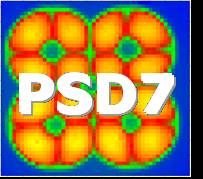Speaker
Dr
Mary-Cruz Fouz-Iglesias
(CIEMAT, Madrid, Spain)
Description
The CMS (Compact Muon Solenoid) is one of the detectors designed to
study the future p-p interactions of the LHC (Large Hadron Collider)
accelerator at CERN. Muons from p-p collisions are expected to
provide clean signatures for many of the interesting processes which
will be studied at LHC. CMS has put a big emphasis on developing a
highly efficient muon system. It consists of four layers of
concentric stations integrated in the return yoke of the 4T
superconducting solenoid. This system will allow identification,
track reconstruction and trigger of muons with momenta from a few
GeV to a few TeV. It uses three different technologies of gaseous
detectors:
For the barrel region, where the expected particle rates are low and
the magnetic field will not be too high, Drift Tube Chambers (DT)
have been chosen. The chambers are made by three independent
subunits called SuperLayers (SL) (2Φ, 1θ) consisting on 4 layers of
drift tubes staggered by half a cell. In addition to the anode wire
and two I-beams with aluminium strips forming the cathodes, the cell
design incorporates two aluminium strips facing the wire which shape
the electric field and improve the linearity in the space-time
relation. Each cell has a resolution <250µm thus ensuring a
resolution <100µm per station. The tests performed in presence of
magnetic field showed that the degradation in the performance
is not significant for the values expected in CMS. Efficiencies per
cell bigger than 99% were obtained.
Chamber electronics include a local trigger system. At the SL level,
the Bunch and Track Identifier identifies the position, angle and
time of passage of the particle by using a meantimer technique. It
provides an efficient local standalone bunch crossing
identification. The two ΦSLs are combined in a Track Correlator
which reduces the noise and improves the angular resolution to
10mrad.
For the endcaps Cathode Strips Chambers (CSC) will be better suited:
they must operate with high rates, and, in addition, the magnetic
field will not be uniform and can reach 3.5 Teslas. The chambers
consist of 6 detecting layers, with strips in the radial direction
providing precise position measurement on the bending plane
(resolutions better than 75 micron can be achieved), and wires
perpendicular to them providing measurement in the radial direction
and giving timing information. Chambers are equipped with trigger
electronics. Muon segments are first found separately by anode and
cathode electronics and then time correlated. A Local Charged Track
(LCT) is formed when a coincidence of ≥4 hit strips (CLCT)
or wires (ALCT) in different layers, belonging to a predefined road
occurs. Cathode trigger is optimised to measure Φ precisely and
anode trigger is optimised for high efficiency bunch crossing
identification A third detector, Resistive Plate Chambers (RPC),
located both in the barrel and in the endcaps, provides a redundant
and complementary trigger. The RPC are gaseous detectors made by two
resistive parallel plates (Bakelite) separated by a few millimetres
gas gap. It can operate in streamer or in avalanche mode but the
streamer mode is not adequate for LHC because the rate capability in
this case is limited ~100Hz/cm2. The RPC design on CMS is made of
two gaps, with common pickup strips in the middle to enhance the
signal. To improve the rate capability Bakelite with "low"
resistivity has been chosen. An excellent time resolution below 3ns,
even at very high rates, is achieved. RPC trigger is performed by
the Pattern Comparator Trigger. It requires a temporal coincidence
of hits in at least 3 muon stations and compares the observed hit
patterns with predefined valid patterns with defined pT. The
bunch crossing is determined by the time coincidence of hits.
Primary author
Dr
Mary-Cruz Fouz-Iglesias
(CIEMAT, Madrid, Spain)
